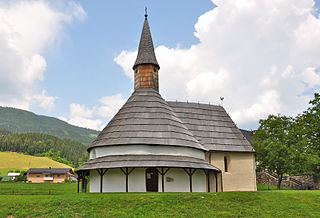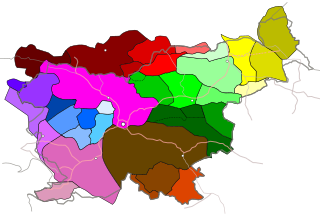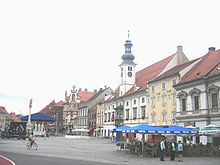
Maribor is the second-largest city in Slovenia and the largest city of the traditional region of Lower Styria. It is the seat of the Urban Municipality of Maribor and the Drava statistical region. Maribor is also the economic, administrative, educational, and cultural centre of eastern Slovenia.
The history of Slovenia chronicles the period of the Slovenian territory from the 5th century BC to the present. In the Early Bronze Age, Proto-Illyrian tribes settled an area stretching from present-day Albania to the city of Trieste. The Slovenian territory was part of the Roman Empire, and it was devastated by the Migration Period's incursions during late Antiquity and the Early Middle Ages. The main route from the Pannonian plain to Italy ran through present-day Slovenia. Alpine Slavs, ancestors of modern-day Slovenians, settled the area in the late 6th Century AD. The Holy Roman Empire controlled the land for nearly 1,000 years. Between the mid-14th century through 1918 most of Slovenia was under Habsburg rule. In 1918, most Slovene territory became part of the Kingdom of Serbs, Croats, and Slovenes, and in 1929 the Drava Banovina was created within the Kingdom of Yugoslavia with its capital in Ljubljana, corresponding to Slovenian-majority territories within the state. The Socialist Republic of Slovenia was created in 1945 as part of federal Yugoslavia. Slovenia gained its independence from Yugoslavia in June 1991, and today it is a member of the European Union and NATO.

Rudolf Maister was a Slovene military officer, poet and political activist. The soldiers who fought under Maister's command in northern Slovenia became known as "Maister's fighters". Maister was also an accomplished poet and self-taught painter.

Carinthia, also Slovene Carinthia or Slovenian Carinthia, is a traditional region in northern Slovenia. The term refers to the small southeasternmost area of the former Duchy of Carinthia, which after World War I was allocated to the State of Slovenes, Croats and Serbs according to the 1919 Treaty of Saint-Germain. It has no distinct centre, but a local centre in each of the three central river valleys among the heavily forested mountains.

Dravograd is a small town in northern Slovenia, close to the border with Austria. It is the seat of the Municipality of Dravograd. It lies on the Drava River at the confluence with the Meža and the Mislinja. It is part of the traditional Slovenian provinces of Carinthia and the larger Carinthia Statistical Region.

The Carinthian plebiscite was held on 10 October 1920 in the area in southern Carinthia predominantly settled by Carinthian Slovenes. It determined the final border between the Republic of Austria and the newly formed Kingdom of Serbs, Croats and Slovenes (Yugoslavia) after World War I. The predominantly Slovene-speaking plebiscite area voted to remain part of Austria with a 59% majority.

Ptuj is the eighth-largest town of Slovenia, located in the traditional region of Styria. It is the seat of the Municipality of Ptuj. Being the oldest recorded city in Slovenia, it has been inhabited since the late Stone Age and developed from a Roman military fort, located at a strategically important crossing of the Drava River along a prehistoric trade route between the Baltic Sea and the Adriatic.

Styria, also known as Slovenian Styria or Lower Styria to differentiate it from Austrian Styria, is a traditional region in northeastern Slovenia, comprising the southern third of the former Duchy of Styria. The population of Styria in its historical boundaries amounts to around 705,000 inhabitants, or 34.5% of the population of Slovenia. The largest city is Maribor.

Anton Korošec was a Yugoslav politician, a prominent member of the conservative People's Party, a Roman Catholic priest and a noted orator.

Muta is the largest settlement and the centre of the Carinthia Statistical Region of northern Slovenia. Traditionally, it is part of Styria because it was part of the Duchy of Styria. The Muta Bistrica flows though the town, where it enters the Drava River.

The Slovene lands or Slovenian lands is the historical denomination for the territories in Central and Southern Europe where people primarily spoke Slovene. The Slovene lands were part of the Illyrian provinces, the Austrian Empire and Austria-Hungary. They encompassed Carniola, southern part of Carinthia, southern part of Styria, Istria, Gorizia and Gradisca, Trieste, and Prekmurje. Their territory more or less corresponds to modern Slovenia and the adjacent territories in Italy, Austria, Hungary, and Croatia, where autochthonous Slovene minorities live. The areas surrounding present-day Slovenia were never homogeneously ethnically Slovene.

Prekmurje Slovene, also known as the Prekmurje dialect, East Slovene, or Wendish, is the language of Prekmurje in Eastern Slovenia, and a variety of the Slovene language. Part of the Pannonian dialect group, it is spoken in the Prekmurje region of Slovenia and by the Hungarian Slovenes in Vas County in western Hungary. It is used in private communication, liturgy and publications by authors from Prekmurje as well as in television, radio and newspapers. It is closely related to other Slovene dialects in neighboring Slovene Styria, as well as to Kajkavian with which it retains a considerable degree of mutual intelligibility, and forms a dialect continuum with other South Slavic languages.

The General Maister Monument is a bronze equestrian statue of Rudolf Maister that stands in a park at Liberation Front Square in front of the Ljubljana railway station. It was created in 1999 by Jakov Brdar as a tribute of the City of Ljubljana to Maister, the first Slovene major general, who secured for Slovenia the city of Maribor.

Peter Štih is a Slovenian historian, specialising in medieval history.

Franjo Malgaj was a Slovenian soldier, military leader and poet. He was an officer of the Austro-Hungarian Army. After the dissolution of the Austro-Hungarian Empire after World War I, he became one of the commanding officers in the Slovene volunteer army under Rudolf Maister's command that fought against German Austrian units during the struggle for the northern Slovenian borderlands. He later became an officer in the Army of Kingdom of Serbs, Croats and Slovenes. He died during the Austrian-Yugoslav struggles in 1919. He is considered a Slovenian national hero.

Mihajlo Rostohar was a Slovenian psychologist, author and educator, who played an important role during the creation of the State of Slovenes, Croats and Serbs. Together with Ivan Hribar and Danilo Majaron, he had a crucial role in the establishment of the University of Ljubljana.

Major General Sherman Miles was an officer of the United States Army, who was Chief of the Military Intelligence Division in 1941, when the Japanese attack on Pearl Harbor happened, bringing the United States into World War II.

Lojze Ude was a Slovene lawyer, journalist and historian.
World War II in the Slovene Lands started in April 1941 and lasted until May 1945. The Slovene Lands were in a unique situation during World War II in Europe. In addition to being trisected, a fate which also befell Greece, Drava Banovina was the only region that experienced a further step—absorption and annexation into neighboring Nazi Germany, Fascist Italy, and Hungary. The Slovene-settled territory was divided largely between Nazi Germany and the Kingdom of Italy, with smaller territories occupied and annexed by Hungary and the Independent State of Croatia.
The Austro-Slovene conflict in Carinthia was a military engagement that ensued in the aftermath of World War I between forces loyal to the State of Slovenes, Croats and Serbs and later the Kingdom of Serbs, Croats and Slovenes, and forces loyal to the Republic of German-Austria. The main theater of the conflict was the linguistically mixed region in southeastern Carinthia. The conflict was settled by the Treaty of Saint-Germain in 1919, which stipulated that the territorial dispute be resolved by a plebiscite.


















